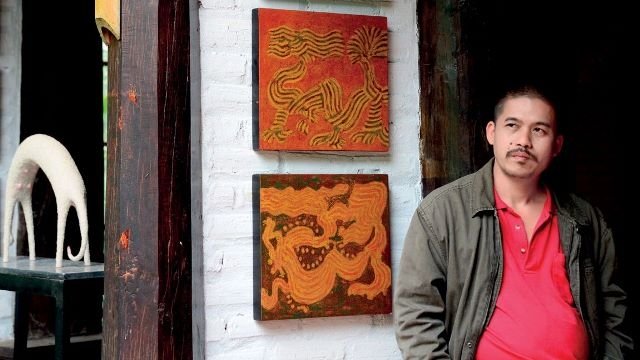


|
|
|
|
Question: Can you please brief us on the major trips you have
made since 2017?
Painter Vu Duc Hieu: In 2016, a museum expert from
Antwerp city, Belgium, paid a one-month visit to our Muong Cultural Space
Museum. He then invited me to visit his museum in June 2017. During my
one-week stay in the Belgian city, I learnt more about the ethnic affairs,
arts, and history of the museum network there.
Following the trip, I took three months from June to August to
tour around 50 museums in more than 10 European countries.
Domestically, I visited Tam Ky city in the central coastal
province of Quang Nam many times last year, working with the local
authorities to provide consultation and make paintings for the Tam Thanh
fishing village, which has become popular among tourists thanks to its
colourful mural paintings.
At the end of 2017, I went on excursions to the northern
province of Son La to make further research on the pottery craft of the Thai
ethnic people in Muong Chanh commune, before heading to Phu Tho province to
provide suggestions on developing community-based tourism in Hung Lo commune.
My last visit of 2017 was to Quanzhou, China, to introduce the
pottery of the Muong people at the Maritime Silk Road International Arts
Festival in mid-December.
During the first three months of this year, I went to Chau Doc
city, An Giang province, to explore the indigenous culture of the Khmer
people. It was followed by two short working trips to Tay Giang district,
Quang Nam province, as a consultant for the local authorities to develop
community-based tourism.
In mid-April this year, I was invited to reproduce an authentic
cultural space of the Muong people at an exhibition held in Ninh Binh
province to celebrate the 1050th anniversary of the establishment of Dai Co
Viet (Great Viet), the first feudal state of Vietnam.
Did you observe any differences between Vietnamese and foreign
museums during these visits?
My talks and working sessions with the museum experts in Belgium
and other European countries have widened my observation of the division in
two forms of the museum sector, which are traditional museums and
contemporary museums.
As traditional museums typically embrace the nation’s history
and pride, they often possess treasured works in their collections, which
attract a long line of local residents and international visitors, who come
to admire the exhibits.
Meanwhile, contemporary museums have to ultilise support from
professional curators and marketing campaigns to attract visitors. When they
want to stage a display on a specific topic, such as anthropology, history,
or the arts, they will call for curators to reassemble, catalogue, and
present the most typical works from around the world which fit the topic the
most.
Exhibitions at such museums also have the support of touch
screen technology, allowing visitors to gain access to a vast source of
knowledge, while developing a direct connection with the exhibits.
The entrance fee is affordable, ranging from EUR8 to EUR20
across Europe.
The situation is not the same in Vietnam as all of the objects
are generally displayed quietly inside a glass box at a majority of museums.
The application of advanced technologies is rarely seen, in just a few
private museums.
What was the most valuable lesson you learnt from your trips?
I think that we should develop a long-term vision on the
development of contemporary museums. Such museums should work to bring the
vitality of traditional culture in a proper context and vividly introduce it
to visitors with state-of-the-art tools.
We need consistent and approved policies on culture to make the
task work effectively. We also need proper investment to maintain and promote
the vitality of our traditional treasured culture.
Thank you so much for your sharing!
|
Source: NDO